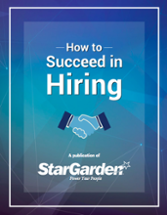4 Hiring Mistakes to Avoid

Hiring is indisputably difficult, time-consuming, and costly. It generally costs much more to hire and train a new employee rather than retain an existing employee, and there’s always a significant risk that the employee won’t work out – won’t perform well, won’t like the environment, or won’t be a good fit with your existing team. How do you hire productive, happy employees who meet your staffing needs and fit into your company’s culture?
Successful hiring starts with two essential components: crafting an accurate, useful job description, and fashioning a captivating job posting or advertisement that attracts quality candidates with relevant experience.
But once you’ve attracted a pool of promising candidates, you’re faced with the daunting task of narrowing them down to those you’d like to get to know better. If you’ve employed creative strategies like asking for additional questions, documentation, writing or project samples, have your hiring team review these carefully. Using workflows can help keep this process organized and efficient.
While winnowing down the pool, reviewing materials, and conducting initial screening interviews by phone and on-line videoconferencing, it can be easy to accidentally eliminate great candidates. Here’s some tips to keep in mind to help prevent sending away winning candidates before the in-person interview stage.
Don’t hire yourself.
It’s tempting to hire people who share similar backgrounds, experience, and personality because you feel more comfortable with them. Try to resist the urge to do this and think outside of the box: candidates with different skill sets and personality than you may make your organization more well-rounded and successful. Great new hires will complement the skills your team already has, not duplicate them.
Don’t rush.
Take time to allow a good selection of candidates to submit applications (and make the deadline for applications clear in the ad). Make the open period long enough for the applicants to spend time and take care in preparing their materials – hopefully, the submissions will reflect that. And think about considering candidates that submit materials late in the process – sometimes the best candidate won’t have the best timing. If his or her materials and application impress you enough, figuring out a way to be flexible in the process can be worth the extra accommodation.
Don’t use arbitrary deal-breakers.
It may drive you crazy when someone confuses “their” and “they’re,” but eliminating an otherwise promising candidate for a field-management position that’s not heavily reliant on stellar written communication skills based on a resume mistake such as this can be counterproductive. Using workflows to design evaluation modules of your candidates can help set quantifiable metrics for whether each applicant meets your needs and wants, and can prevent your hiring team from rejecting (or approving) applicants on arbitrary bases.
Don’t over- or under-select.
Interviewing candidates is a draining process, which uses time and resources from your existing employees, so don’t select too many for follow-up. However, don’t be too selective – you want a number of diverse candidates who all seem promising. If you don’t find a good selection, consider extending the application date or making the job posting’s qualification requirements less constrained.
StarGarden’s integrated HR software solutions can help you hire and manage your most important asset – your people! Our HCM workflows are customizable to every step of the hiring process and beyond. Cloud-based payroll and HCM systems bring everything you need to efficiently hire, onboard, and manage your employees together in one place. Find out more about the benefits of an integrated HR & payroll system by contacting us or visiting www.stargarden.com.
Download our complimentary eBook with tips to help you through the entire hiring process by clicking the link below.

